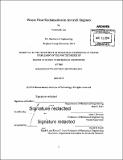| dc.contributor.advisor | John G. Brisson. | en_US |
| dc.contributor.author | Lee, Victoria D. Lee (Victoria Dawn) | en_US |
| dc.contributor.other | Massachusetts Institute of Technology. Department of Mechanical Engineering. | en_US |
| dc.date.accessioned | 2015-06-10T19:08:58Z | |
| dc.date.available | 2015-06-10T19:08:58Z | |
| dc.date.copyright | 2014 | en_US |
| dc.date.issued | 2014 | en_US |
| dc.identifier.uri | http://hdl.handle.net/1721.1/97318 | |
| dc.description | Thesis: S.M., Massachusetts Institute of Technology, Department of Mechanical Engineering, 2014. | en_US |
| dc.description | Cataloged from PDF version of thesis. | en_US |
| dc.description | Includes bibliographical references (pages 94-96). | en_US |
| dc.description | Introduction: Rotorcraft engines can lose up to 70% of the potential chemical energy of their fuel as waste heat. Harvesting this waste heat and converting it to useful work would improve the efficiency and power output of the engine. Figure 1 shows two possible engine systems in which a secondary engine could be used to harvest waste heat. For the gas turbine engine in Figure 1A, the main source of waste heat is the enthalpy of the engine's exhaust gases. In the case of the spark ignition engine in Figure 1B, there are three sources of waste heat: the enthalpy available in the exhaust gases, the heat rejected by the coolant loop, and the heat rejected by the oil loop. For each engine system, the heat from waste heat engine is rejected to the ambient air. Possible candidate systems for waste heat recovery include closed cycle systems such as the Rankine and Brayton engines. Rankine engines typical use water as a working fluid. The performance of water-based Rankine engines suffer from low pressures in the working fluid at the temperatures of the ambient and, therefore, require large low pressure expanders and condensers to operate efficiently. Organic working fluids have higher vapor pressures and can be used in Rankine engines instead of water. The higher vapor pressures of these fluids allow the use of smaller expanders. However, organic working fluids are limited to temperatures below 250 C, which is substantially lower than the typical temperatures available in the waste streams. Brayton engines can operate at higher temperatures using inert gases such as helium and argon as working fluids. In either of these engines, the turbomachinery and heat exchangers must remain leak tight as the working fluid is cycled through at high temperatures and high pressures. As a consequence of this requirement, these cycles will not be considered further in this work. Thermoelectric devices, on the other hand, do not require leak tight passages or turbomachinery. These are compacted and are expected to have a higher reliability since they have no moving parts. These advantages have motivated this study on thermoelectrically-based waste heat engine. For a thermoelectrically-based waste heat engine to be feasible, it must be capable of absorbing and rejecting large amounts of heat in part to compensate for the low efficiencies of thermoelectric materials. It must also be light weight and compact to address concerns of power to weight ratios and space constraints in rotorcraft. Therefore, the waste heat engine must be designed to minimize thermal resistance while also minimizing the mass and volume of the heat exchangers. | en_US |
| dc.description.statementofresponsibility | by Victoria D. Lee. | en_US |
| dc.format.extent | 96 pages | en_US |
| dc.language.iso | eng | en_US |
| dc.publisher | Massachusetts Institute of Technology | en_US |
| dc.rights | M.I.T. theses are protected by copyright. They may be viewed from this source for any purpose, but reproduction or distribution in any format is prohibited without written permission. See provided URL for inquiries about permission. | en_US |
| dc.rights.uri | http://dspace.mit.edu/handle/1721.1/7582 | en_US |
| dc.subject | Mechanical Engineering. | en_US |
| dc.title | Waste heat reclamation in aircraft engines | en_US |
| dc.type | Thesis | en_US |
| dc.description.degree | S.M. | en_US |
| dc.contributor.department | Massachusetts Institute of Technology. Department of Mechanical Engineering | |
| dc.identifier.oclc | 910256473 | en_US |
